A puppet state, puppet régime, puppet government or dummy government is a state that is de jure independent but de facto completely dependent upon an outside power and subject to its orders. Puppet states have nominal sovereignty, except that a foreign power effectively exercises control through economic or military support. By leaving a local government in existence the outside power evades all responsibility, while at the same time successfully paralysing the local government they tolerate.
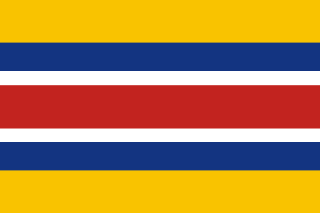
Mengjiang, also known as Mengkiang or the Mongol Border Land, officially the Mengjiang United Autonomous Government, was an autonomous zone in Inner Mongolia, formed in 1939 as a puppet state of the Empire of Japan, then from 1940 being under the nominal sovereignty of the Reorganized National Government of the Republic of China. It consisted of the previously Chinese provinces of Chahar and Suiyuan, corresponding to the central part of modern Inner Mongolia. It has also been called Mongukuo or Mengguguo. The capital was Kalgan, from where it was under the nominal rule of Mongol nobleman Demchugdongrub. The territory returned to Chinese control after the defeat of the Japanese Empire in 1945.

Demchugdongrub, also known as Prince De, courtesy name Xixian, was a Qing dynasty Chinese Mongol prince descended from the Borjigin imperial clan who lived during the 20th century and became the leader of an independence movement in Inner Mongolia. He was most notable for being the chairman of the pro-Japanese Mongol Military Government (1938–39) and later of the puppet state of Mengjiang (1939–45), during the Second Sino-Japanese War. In the modern day, some see Demchugdongrub as a Mongol nationalist promoting Pan-Mongolism, while others view him as a traitor and a pawn of the Japanese during World War II.
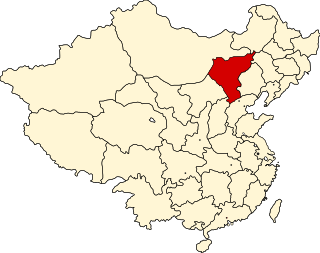
Chahar, also known as Chaha'er, Chakhar or Qahar, was a province of the Republic of China in existence from 1912 to 1936, mostly covering territory in what is part of Eastern Inner Mongolia. It was named after the Chahar Mongols.

The National Emblem of the People's Republic of China is a national symbol of the People's Republic of China and contains in a red circle a representation of Tiananmen Gate, the entrance gate to the Forbidden City, where Mao Zedong declared the foundation of the People's Republic of China (PRC) in 1949. Above this representation are the five stars found on the national flag. The largest star represents the Chinese Communist Party (CCP), while the four smaller stars represent the four social classes as defined in Maoism. The emblem is described as being "composed of patterns of the national flag":
...The red color of the flag symbolizes revolution and the yellow color of the stars the golden brilliant rays radiating from the vast red land. The design of four smaller stars surrounding a bigger one signifies the unity of the Chinese people under the leadership of the Communist Party of China (CPC).
—China Yearbook 2004

Five Races Under One Union was one of the major principles upon which the Republic of China was founded following the 1911 Revolution. Its central tenet was the harmonious existence under one nation of what were considered the five major ethnic groups in China: the Han, the Manchu, the Mongols, the Hui (Muslims), and the Tibetans.
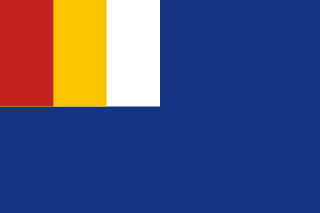
The Inner Mongolian Army, also sometimes called the Mengjiang National Army, referred to the Inner Mongolian military units in service of Imperial Japan and its puppet state of Mengjiang during the Second Sino-Japanese War, particularly those led by Prince Demchugdongrub. It was primarily a force of cavalry units, which mostly consisted of ethnic Mongols, with some Han Chinese infantry formations.

The East Hebei Autonomous Government, also known as the East Ji Autonomous Government and the East Hebei Autonomous Anti-Communist Government, was a short-lived late-1930s state in northern China. It has been described by historians as either a Japanese puppet state or a buffer state.

The flag of the Empire of Manchuria had a yellow field with four horizontal stripes of different colours in the upper-left corner. The colours of the flag were based on the colours on the Five Races Under One Union flags used by the Beiyang government, the Empire of China, and by the Fengtian clique. The flag was first established in Announcement of National Flag on 1 March 1932.
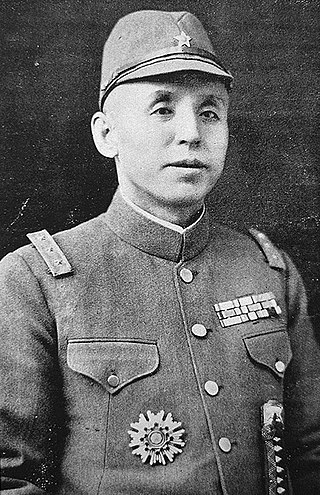
Li Shouxin was a pro-Japanese commander in the Manchukuo Imperial Army and later the Mengjiang National Army.

The national flag of the People's Republic of China, also known as the Five-star Red Flag, is a Chinese red field with five golden stars charged at the canton. The design features one large star, with four smaller stars in an arc set off towards the fly. It has been the national flag of China since the foundation of the People's Republic of China on 1 October 1949. The flag was designed by Zeng Liansong.
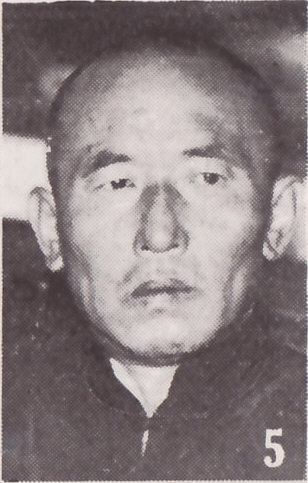
Yu Pinqing was a politician and industrialist in the Republic of China. He was Supreme Member of the Southern Chahar Autonomous Government, later he was also appointed vice-chairman of the Mongolian United Autonomous Government and the Mongolian Autonomous Federation. He was born in Nangong, Zhili (Hebei).

Xia Gong was a politician of the Republic of China. He was the Head of the Japanese puppet government known as the North Shanxi Autonomous Government. Later he was appointed Vice-Chairman of the Mengjiang United Autonomous Government. He was born in Datong County, Shanxi province.

The Mongol United Autonomous Government was a Japanese puppet regime in Inner Mongolia from 1937 to 1939.

The North China Buffer State Strategy is the general term for a series of political manoeuvrings Japan undertook in the five provinces of northern China, Hebei, Chahar, Suiyuan, Shanxi, and Shandong. It was an operation to detach all of northern China from the power of the Nationalist Government and put it under Japanese control or influence.

Five Races Under One Union was used as a national motto in Manchukuo, for the five ethnic groups of the Manchus, the Japanese, the Han Chinese, the Mongols and the Koreans. It was similar to the "Five Races Under One Union" motto used by the Republic of China, for the Han, Manchus, Hui, Mongols and Tibetans, but the third of the four Chinese characters was changed from Togetherness (共) to Cooperation (協). Both mottoes were pronounced the same "Go zoku kyōwa" in Japanese.

The Yuan of Mengjiang is the monetary unit that was issued in 1937–1945 by several governments of Mengjiang.

The North Shanxi Autonomous Government was an administratively autonomous component of Mengjiang from its creation in 1937 to its complete merger into Mengjiang in 1939. Following the Japanese invasion of China in July 1937, regional governments were established in Japanese-occupied territories. After Operation Chahar in September 1937, which extended Japanese control to northern Shanxi region, more formal control of the area was established through the creation of the North Shanxi Autonomous Government, as well as the South Chahar Autonomous Government to the east of Shanxi.
Cui Xiaoqian was a government figure in both Mengjiang and North Shanxi during the Second Sino-Japanese War when these regions were under Japanese occupation. Little information is known about Cui himself, though his position inside the North Shanxi Autonomous Government is apparent.
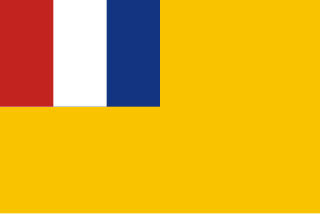
The South Chahar Autonomous Government was a puppet state of the Empire of Japan, as well as an administratively autonomous component of Mengjiang from its creation in 1937 to its complete merger in 1939. Following the Japanese invasion of China in July 1937, regional governments were established in Japanese-occupied territories. After Operation Chahar in September 1937, which extended Japanese control to northern Shanxi region, more formal control of the area was established through the creation of the North Shanxi Autonomous Government, as well as the South Chahar Autonomous Government to the east of Shanxi.
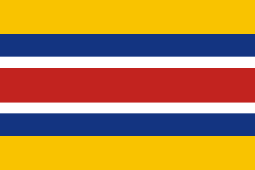

 Flag of the South Chahar Autonomous Government (1938-1939)
Flag of the South Chahar Autonomous Government (1938-1939)


















